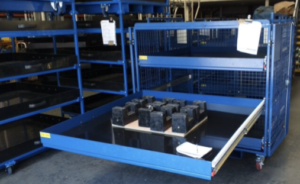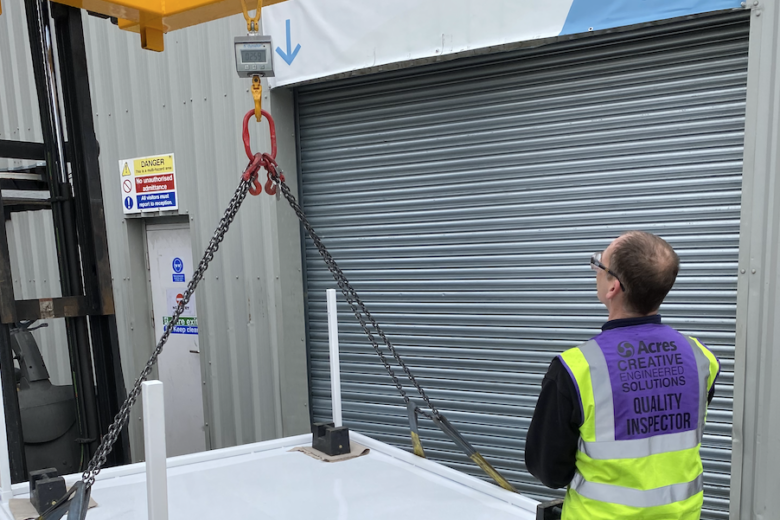What is load testing? SWL?
Acres Engineering manufacture many different types of products, some of which require proof load testing, or load testing in order to issue a Safe Working Load (SWL) certificate and sticker. This SWL certification process is a very important stage of product validation and testing to ensure that the solution is safe to perform the task that it was designed for.
Proof load testing is a specific type of load testing used to verify that a structure or component can safely carry a designated load without experiencing failure or permanent deformation. It is often applied in industries such as construction, manufacturing, and engineering to ensure the safety and reliability of various equipment and structures. Key Aspects of Proof Load Testing involve:
- Load Application: The component or structure is subjected to a predetermined load, typically higher than the maximum expected operational load, to ensure a margin of safety.
- Verification: The purpose is to confirm that the component or structure can withstand the applied load without any signs of distress, such as cracks, excessive deflection, or other forms of damage.
- Documentation: Detailed records of the test procedures, applied loads, and observed results are maintained for quality assurance and compliance purposes.
Acres can carry out proof load tests onsite where required:

What is the purpose of proof load testing?
The purpose of proof load testing is to verify that a component, structure, or system can safely carry a designated load without experiencing failure or permanent deformation. This type of testing ensures the reliability, safety, and performance of the tested item under operational conditions. Here are the key purposes of proof load testing:
1. Safety Assurance
- Prevent Failures: Proof load testing helps prevent catastrophic failures by ensuring that components and structures can handle the loads they will encounter during service.
- Compliance with Safety Standards: It ensures that the tested items meet industry and regulatory safety standards, which is crucial for public safety and legal compliance.
2. Performance Verification
- Load Capacity Confirmation: It confirms that the component or structure can handle the specified load without experiencing unacceptable levels of deformation or damage.
- Quality Assurance: Proof load testing verifies that the materials and construction methods used in the component meet the required quality standards.
3. Reliability and Durability Assessment
- Longevity Estimation: By testing how a component performs under load, engineers can better estimate its lifespan and schedule maintenance or replacements accordingly.
- Identification of Weaknesses: The test can reveal potential weaknesses or areas of concern that may need to be addressed to improve the overall reliability of the system.
4. Design Validation
- Prototype Testing: For new designs, proof load testing is essential to validate that the design meets the required specifications and can perform under expected load conditions.
- Engineering Feedback: The results provide valuable feedback to engineers, which can be used to refine and improve the design.
5. Regulatory and Certification Compliance
- Meeting Legal Requirements: Many industries have strict regulations that mandate proof load testing as part of the certification process for critical components and structures.
- Certification: Successful proof load testing can be a requirement for obtaining certification from regulatory bodies, which is often necessary for market entry and customer trust.
6. Risk Management
- Mitigating Risks: By verifying load capacity and performance, proof load testing helps in identifying and mitigating risks associated with structural failures or component malfunctions.
- Insurance and Liability: Demonstrating that a component has passed proof load testing can reduce liability and may be required by insurers to provide coverage.
7. Economic Efficiency
- Cost Savings: Identifying potential issues before components are deployed in the field can save costs associated with repairs, replacements, and downtime due to failures.
- Resource Optimisation: Ensuring that components are fit for purpose helps in optimising resources and materials, preventing over-design or under-design.

Is load testing manditoary?
Proof load testing is often a mandatory requirement in the UK for certain types of equipment and structures, especially those related to safety-critical applications. The specific requirements for proof load testing are governed by various regulations, standards, and guidelines depending on the industry and type of equipment. Here are some key areas where proof load testing is typically required:
1. Lifting Equipment
- Regulations: The Lifting Operations and Lifting Equipment Regulations (LOLER) 1998 require that all lifting equipment used at work is thoroughly examined and tested to ensure safety.
- Requirements: Proof load testing is part of the thorough examination process to confirm that lifting equipment such as cranes, hoists, and lifting accessories can handle the loads they are rated for without failure.
2. Construction
- Regulations: The Construction (Design and Management) Regulations 2015 (CDM 2015) require that structures and equipment used in construction are safe and fit for purpose.
- Requirements: Proof load testing is often required for temporary structures, scaffolding, and formwork to ensure they can withstand the expected loads during construction activities.
3. Marine and Offshore
- Regulations: The Marine Equipment Directive (MED) and other maritime safety standards mandate proof load testing for various marine and offshore equipment.
- Requirements: Equipment such as lifeboats, davits, mooring systems, and offshore cranes must undergo proof load testing to ensure they can perform safely under operational conditions.
4. Engineering and Manufacturing
- Standards: Various British Standards (BS), European Standards (EN), and International Standards (ISO) specify proof load testing requirements for different engineering and manufacturing components.
- Requirements: Proof load testing is required for critical components like pressure vessels, structural steelwork, and other load-bearing elements to ensure they meet safety and performance standards.
5. Railway Infrastructure
- Regulations: The Railway Safety Regulations and standards set by entities like the Office of Rail and Road (ORR) require that railway infrastructure components are tested for safety and reliability.
- Requirements: Bridges, overhead line equipment, and other critical railway infrastructure components may need to undergo proof load testing to confirm their ability to handle operational loads.
Compliance and Enforcement
Compliance with these regulations is typically enforced by relevant authorities and regulatory bodies. Failure to comply with proof load testing requirements can result in legal penalties, fines, and increased liability in the event of accidents or failures.
What are the rules around load test re-certification?
Re-checking proof load tested items, also known as periodic retesting or re-certification, is essential to ensure continued safety and compliance with regulations. The frequency and circumstances under which proof load tested items need to be rechecked depend on several factors, including regulatory requirements, industry standards, manufacturer recommendations, and the specific conditions under which the items are used. Here are the key factors and guidelines for determining when to recheck proof load tested items:
1. Regulatory Requirements
- Lifting Equipment: Under the Lifting Operations and Lifting Equipment Regulations (LOLER) 1998 in the UK, lifting equipment must be thoroughly examined at least every 12 months for equipment used for lifting persons or accessories for lifting, and every 6 months for all other lifting equipment. Additional examinations are required if exceptional circumstances occur.
- Construction Equipment: Equipment used in construction, such as scaffolding or temporary structures, may have specific retesting intervals mandated by regulations or standards.
- Marine and Offshore Equipment: Maritime regulations and guidelines may specify retesting intervals for safety-critical equipment like lifeboats and cranes.
2. Industry Standards
- Various industry standards, such as those from the British Standards Institution (BSI), European Standards (EN), or International Organization for Standardisation (ISO), provide guidelines on retesting intervals for specific equipment.
- Standards often recommend periodic testing based on the type of equipment, its usage, and the environment in which it operates.
3. Manufacturer Recommendations
- Equipment manufacturers typically provide guidelines on the recommended intervals for retesting or re-certifying their products.
- Following manufacturer recommendations ensures that the equipment is maintained according to its designed safety and performance specifications.
4. Usage and Operational Conditions
- High-Usage Items: Equipment subjected to frequent or heavy use may require more frequent retesting to ensure continued safety and reliability.
- Harsh Environments: Equipment operating in harsh environments (e.g., marine, offshore, corrosive environments) may need more frequent inspections and testing due to accelerated wear and potential damage.
- Alterations or Repairs: If an item has been significantly altered, repaired, or modified, it should be rechecked to ensure that the changes have not affected its load-bearing capacity or safety.
5. Incidents and Exceptional Circumstances
- Accidents or Near-Misses: If an item has been involved in an accident, near-miss, or any incident that could have affected its structural integrity, it should be rechecked immediately.
- Unusual Loads or Stresses: If an item has been subjected to loads or stresses beyond its designed capacity, it should be rechecked to ensure no damage has occurred.
6. Scheduled Maintenance Programs
- Many organisations implement scheduled maintenance programs that include periodic proof load testing as part of their routine maintenance to ensure ongoing compliance and safety.
Typical Rechecking Intervals
While specific intervals can vary, here are some general guidelines for rechecking proof load tested items:
- Lifting Equipment: Every 6-12 months, depending on the type and usage.
- Construction Equipment: Annually or as specified by regulatory guidelines.
- Marine and Offshore Equipment: As specified by maritime regulations and manufacturer recommendations, often annually or biannually.
- Critical Infrastructure Components: According to engineering standards and risk assessments, typically every 1-5 years.

What are the steps involved with initially carry out a load test?
1. Preparation: iIdentifying the Component or Structure:
- Determine which component or structure needs to be tested. This could be anything from a bridge beam to a crane hook.
- Understand the function and importance of the component within the overall system to prioritize testing efforts.
Determining the Proof Load:
- Review design specifications and manufacturer guidelines to establish the proof load. This load is typically a percentage above the maximum operational load to ensure a safety margin.
- Consider industry standards and regulatory requirements, which may dictate specific proof load values and testing procedures.
- Calculate the proof load using relevant safety factors. For example, if the maximum operational load is 10 tons and the safety factor is 1.5, the proof load would be 15 tons.
Test Planning:
- Develop a detailed test plan outlining the procedure, equipment required, safety precautions, and personnel involved.
- Ensure all necessary permits and approvals are obtained, particularly if the testing involves public infrastructure or regulated industries.
2. Load Application: setting Up the Testing Environment:
- Arrange the component or structure in a controlled environment where variables can be closely monitored.
- Ensure the test area is secure and that all safety measures, such as barriers and warning signs, are in place.
Using Appropriate Equipment:
- Select and set up the equipment needed for applying the load. This might include hydraulic jacks, load cells, weights, or other mechanisms.
- Calibrate the testing equipment to ensure accurate load application and measurement.
Gradual Load Application:
- Apply the load gradually to avoid sudden stress that could cause premature failure or inaccurate results.
- Follow the step-loading process, where the load is increased incrementally, and each increment is held for a specified period to observe the component’s behaviour.
3. Observation and Measurement – monitoring for Signs of Distress:
- Continuously observe the component for any signs of distress, such as cracks, deformations, unusual noises, or other indicators of failure.
- Use visual inspection, acoustic emission sensors, and other non-destructive testing techniques to detect issues.
Measuring Parameters:
- Measure relevant parameters such as deflection (bending), strain (deformation), and stress (force per unit area) using appropriate instruments like strain gauges and deflection meters.
- Record data at each load increment to create a detailed performance profile of the component under test.
4. Evaluation – data Analysis:
- Analyse the collected data to determine how the component responded to the applied load. Look for deviations from expected behaviour, which could indicate potential issues.
- Compare the results against design specifications and safety standards to assess whether the component has passed the test.
Assessing Performance:
- Evaluate the performance in terms of safety, reliability, and compliance with industry standards.
- Identify any weaknesses or potential failure points that need to be addressed before the component is put into service.
5. Reporting – documenting the Test Process:
- Create a comprehensive report detailing the test procedure, equipment used, load increments, observations, and measurements.
- Include photographs, diagrams, and data charts to provide a clear and complete record of the test.
Results and Recommendations:
- Summarise the test results, highlighting whether the component passed or failed the proof load test.
- Provide recommendations for any necessary corrective actions, such as design modifications, material changes, or additional testing.
Archiving and Compliance:
- Store the test documentation in accordance with industry regulations and company policies for future reference and audits.
- Ensure that all stakeholders, including engineers, quality assurance teams, and regulatory bodies, have access to the test results and report.
Proof load testing is essential for ensuring the safety, reliability, and performance of critical components and structures in various industries. By following these detailed steps, organisations can systematically verify that their components can handle the required loads and meet the necessary safety standards.
Acres have a range of standard products but also support clients with custom machinery and medium-high volume products such as trolleys, stillages etc.
We have manufactured lots of different tables / workstations / workbenches for various industries.
We also manufacture access platforms, jigs and fixtures and many other types of production support solutions / products.
Talk to us today about your requirements: [email protected] / 01332695240 / Contact Us Form
Click on the icon to check out our social media! Please follow, like and share!
Want to know more about Acres Engineering?
We are based in the UK from our Headquarters in Derbyshire, England and have a European office in Malaga, Spain within the EU.
Find out more about where we have been and what we have been up to by checking out our latest blog posts.
Take a look at how we support of the Armed Forces, STEM/Schools and Charities.
As a world leader in our field, we offer a range of information guides sharing best practice with our clients.
We make it easy to engage with us, we are approved on: EcoVadis (external) / JOSCAR (external) / AVETTA (external) / COUPA (external) / SAP ARIBA (external) / DEEPSTREAM (external) ….you can download our BSI / Insurance certificates here.




![]()
![]()
![]()






